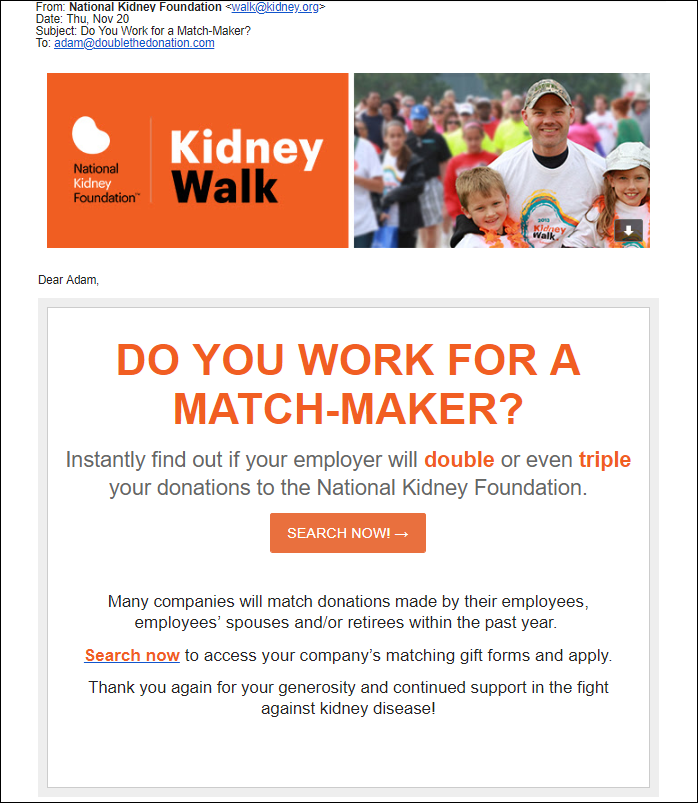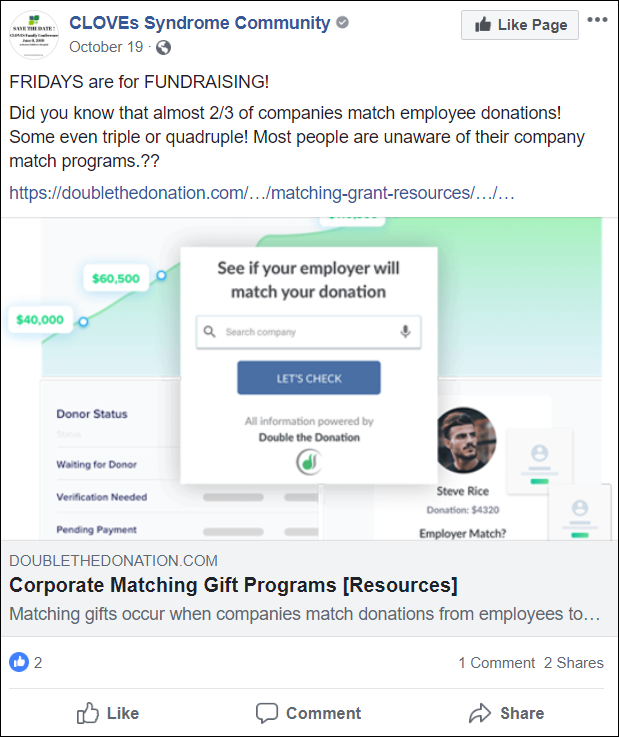- The process of matching gifts
- The elements of matching gift guidelines
- How to market matching gifts
- Matching gifts best practices
1. The process of matching gifts
No matter the company, the employee, or the organization receiving the donation, the process for matching gifts is always the same. The first step, of course, is the initial donation. There can be no matching gift without a gift to match! After the donation, the donor must submit a matching gift request to their employer. This step is where we see the most breakdown in the process, by far. It’s not that donors don’t want to help your organization, they’ve already made a donation. The problem is that many donors don’t know what matching gifts are. This is why marketing is so important. Once you tell donors about the incredible opportunity that is matching gifts, your revenue will increase exponentially! More on that later… The third step is in the hands of the company making the matching gift. Large companies usually have a matching gifts agent or team who is responsible for confirming that the initial donation, the donor, and the organization all qualify for a matching gift. If the donation seems to qualify for a match, the company will reach out to the nonprofit to verify that the donation was made as reported. Once all of those boxes are checked, we move to the final step, which is when the nonprofit receives the matching gift! Now let’s take a closer look at what determines whether or not a donation qualifies for a matching gift.2. The elements of matching gift guidelines
Although each company sets its own matching gift guidelines, the elements found in these programs are always the same. These elements will ultimately determine exactly how much a company will donate in response to the initial donation. First of all, there is always a minimum and maximum donation amount that qualifies for a match. If an employee donates $10, and the minimum is $15, there is no match. On the other end of the spectrum, if an employee’s initial donation exceeds the set maximum, the company will match that donation up to the set maximum. Another factor that determines the amount a company will donate is the match ratio. The most common ratio is 1:1, which is an exact match. However, the match ratio can be something different. For example, American Express typically matches at a 1:1 ratio, but if the employee who made the initial donation also sits on the board of the nonprofit they donated to then American Express offers a 2:1 match. The employee’s status at the company can also impact the amount of their match. At Soros Fund Management full-time employees qualify for a 3:1 match, while partners qualify for a smaller (but still impressive) 2:1 match. Some matching gift guidelines also specify the kinds of nonprofits they will support, as opposed to matching gifts to any 501(c)(3). A somewhat odd example of this is found in the trend of airlines supporting educational organizations. So the nonprofit eligibility is also a factor of matching gifts. And of course, there is always a deadline to consider. Whether it’s a threshold deadline (90 days after initial donation) or a firm date (often December 31), it is important to make sure that your donors know the deadline by which they need to submit their matching gift requests. These are the elements that impact whether a match is made and for how much. It’s helpful to know about these metrics because they will, in a way, shape your matching gift revenue.3. How to market matching gifts
As stated earlier, the biggest hindrance to matching gifts is lack of donor awareness. The most important thing a nonprofit organization can do to increase matching gift revenue is commit to spreading the word to as many donors as possible. Nonprofits can’t request matching gifts from companies whose employees have already donated, the employees have to do it. Making sure those employees/donors know about matching gifts becomes priority number one. The best places to inform donors about matching gifts are:- On your donation form
- Following the donation
- Dedicated matching gifts page
- Emails and social media
On your donation form
When a donor is already on your donation form, you know one thing for sure: they want to support your organization. They are so interested in supporting your organization, that they are willing to sacrifice their own money. This is an excellent place to incorporate matching gifts. The Leukemia and Lymphoma Society has a particularly smooth donation process, which includes a matching gift search tool as a field on their donation form.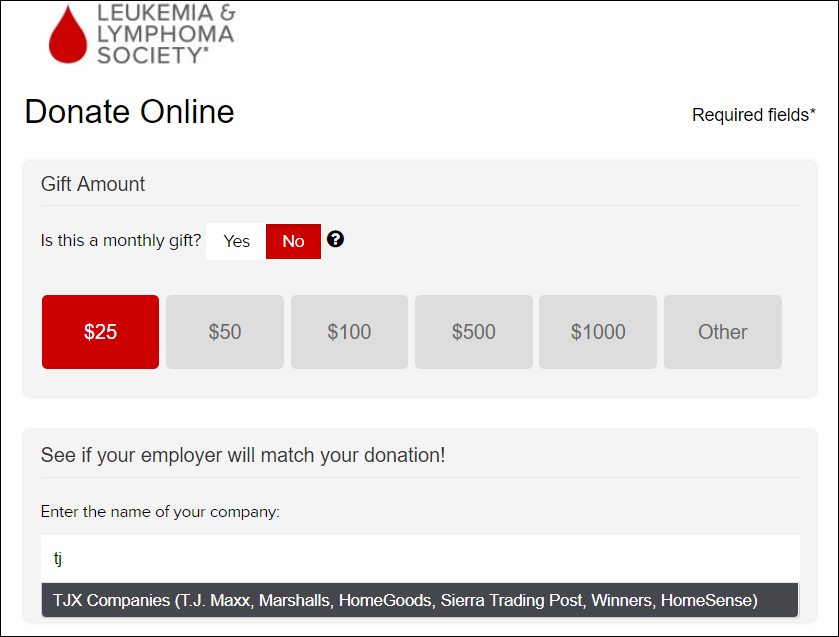
Following the donation
Immediately after the donation is made, the donor is always presented with a confirmation screen. This is another great place to include a matching gift search tool. Presenting the donor with a way of finding the matching gift program they qualify for while they are still being driven by whatever brought them to your form in the first place is a great way to increase matching gift revenue.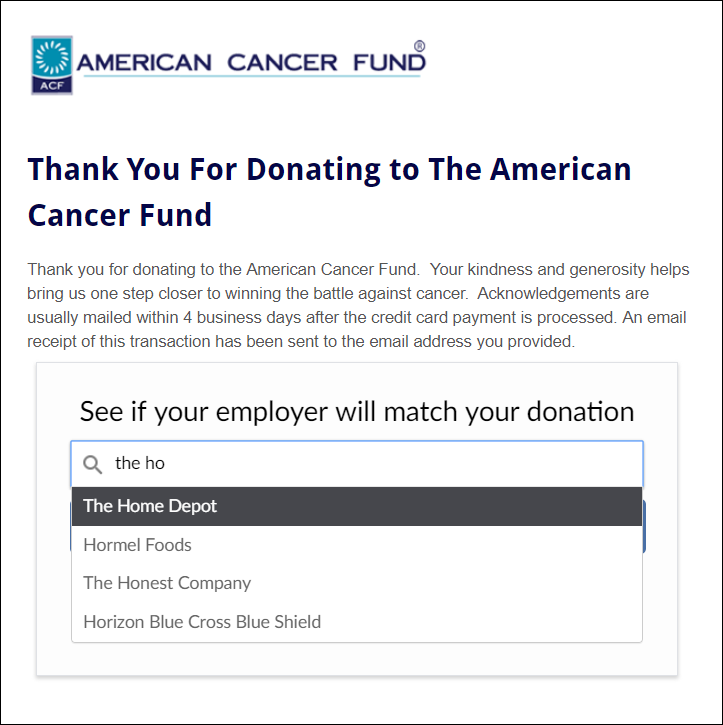
The American Cancer Fund has a simple confirmation page that gets right to the point. They say thank you, address what the money will be used for, and then encourage donors to “See if your employer will match your donation.”
This is a simple and direct confirmation page, which instantly helps your organization start raking in the matching gift revenue.
Dedicated matching gifts page
The previous two suggestions were for informing donors already in the process of donating, but what about everyone else? It’s crucial that your organization’s website have a dedicated matching gifts page where casual visitors to your site can learn about matching gifts.
This is so important because 84% of donors say that they’re more likely to give if their gift will be matched, so you have to give potential donors a way of finding that information.
Plus, you can link to your dedicated matching gift page everywhere. You can link to it in your email signature, you can post it on social media, you can even print the URL on physical mailers.
A great example of such a dedicated matching gift page is found on the ASPCA’s website. Notice how they explain what matching gift programs are, mention how easy it is to request a matching gift, and then offer a matching gift search tool for donors to check their own match-eligibility.
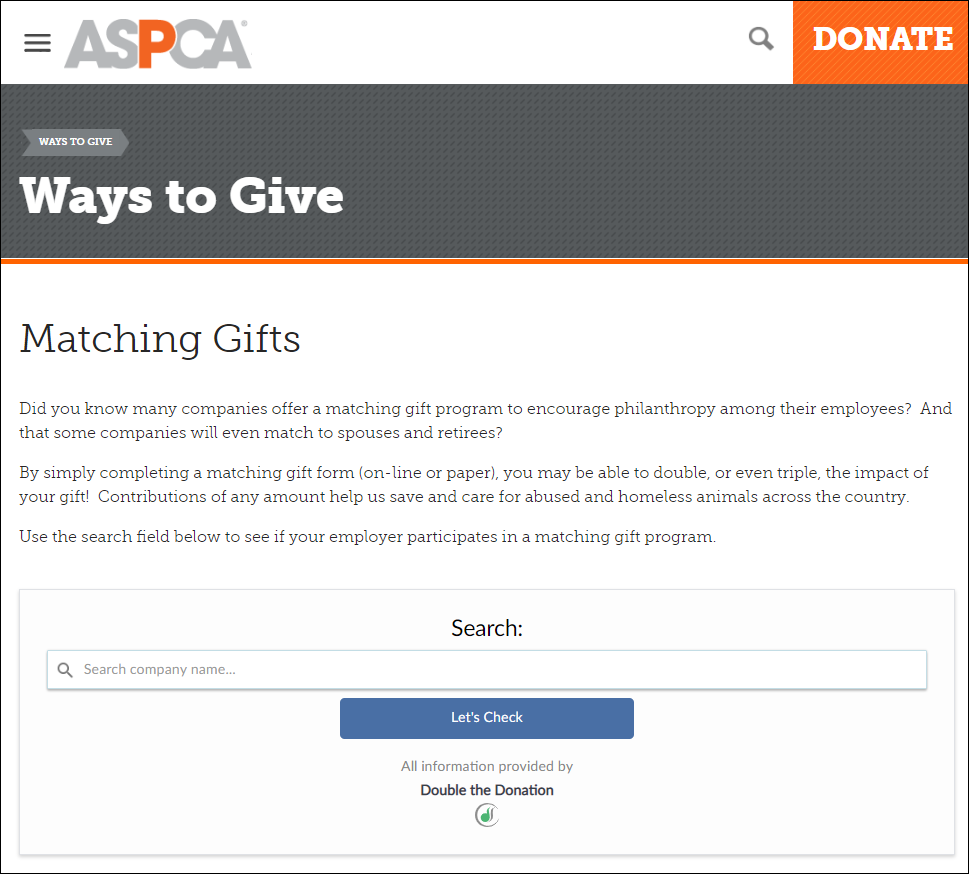
Just mentioning matching gifts in your fundraising appeals results in a 71% increase in response rate and a 51% increase in the average donation amount. All the more reason to include a matching gifts page on your website and mention it in all of your fundraising campaigns.
Emails and social media
The most direct ways of communicating with your donors are email and social media. Your website is not targeted, but these communications are.
You can really tailor your message to convey exactly what you want your donors to learn. We highly recommend sending an email specifically focused on matching gifts. Of course, you should link to your dedicated matching gifts page so that potential donors can search for their employer, but the email itself should contain an explanation of what matching gifts are and encourage readers to learn more.
